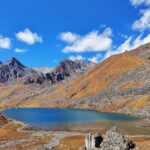When it comes to trekking in Nepal, the Annapurna Base Camp vs Everest Base Camp always puts trekkers in a dilemma. These basecamp treks are two of the most sought-after destinations in Nepal and feature on the bucket list of many trekking enthusiasts. However, deciding between the two can be a daunting task. Both treks offer unique and breath-taking experiences that are worth your time and effort. To help you make an informed decision, we have provided a detailed analysis of each trek.
Let’s compare the basic highlights of Annapurna Base Camp vs Everest Base Camp.
Annapurna Base Camp Trek (ABC) vs Everest Base Camp Trek (EBC)
| ABC | EBC |
| Altitude – 13,550ft | Altitude – 18,513ft |
| Duration – 10 Days | Duration – 14/16/21 Days, depending on the EBC Route |
| Trek Distance – 67 km | Trek Distance – 130 Km |
| Temperature – 20°C to 5°C ( Spring Months) 15°C to – 5 °C (Autumn Months) | Temperature – Spring Months 18 °C to 0 °C ( Spring Months) 12 °C to – 10 °C (Autumn Months) |
| Starting Point – Pokhara, followed by a drive to Gandruk | Starting Point – Kathmandu, followed by Flight to Lukla |
| Best Season – Spring, Autumn, Winter | Best Season – Spring and Autumn |
Annapurna Base Camp vs Everest Base Camp
The two of the most popular treks of Nepal have so much resemblance yet are miles apart if we sit down to compare. Annapurna Basecamp Trek, also known as ABC, takes you to the basecamp of one of the most dangerous and difficult mountains to climb in the world. Everest Basecamp trek takes you to the basecamp of the world’s highest mountain.

The ABC trek spreads over 10 days and is located inside the Annapurna Sanctuary. On your way to the base camp of Annapurna, you will come face to face with some of the biggest peaks in the world. ABC experience is a treasure every mountain admirer wishes to find as they encounter the exotic and captivating view of Annapurna 1, Annapurna 2, Annapurna Glacier, Himchuli, and Mahcapuchre from unprecedented distances. The sight of these eight thousanders is unparalleled.
Everest Basecamp
Not everyone can be on the top of the world, however, if you are ready to work on your fitness you can experience the top of the world from a close distance. Summiting Everest is on the bucket list of every mountaineer, and reaching its base camp is also no less of an accomplishment. The Everest basecamp trek, commonly known as EBC is located inside the Sagarmatha National Park and can be completed in 13-14 days if you choose the standard route. The trek offers a few other routes that trekkers can consider depending on their fitness level, budget, and time available. The other two routes for EBC Trek are via Gokyo Ri and Three High Passes.
1. ABC vs EBC: Summit Views
Not many are aware of the fact that Everest is not visible from its base camp. To witness Everest in all its glory, you have to climb the Kala Patthar situated at an altitude of 18200ft. The summit experience on EBC is surreal as you meet global climbers. You will witness them preparing for their most important day of life. As you summit the Kalapathar in the wee hours, the first ray of the sun gleaming behind Everest is mesmerizing. The sight of mighty Everest amazes you to the core.

The view on the summit day of ABC is known for changing many lives. You wake up early to enjoy the first ray of sunlight falling on Annapurna Massif. The view when the sun’s rays fall on the peaks, glowing with a tint of orange and red is when you feel accomplished. The sight in front of you, the changing colours of the peaks, and the sky are unfathomable.
The base camp is thronged by climbers and trekkers from around the world. The sight you witness is something unprecedented. The base camp also has memorials of the climbers who lost their lives while trying to summit Annapurna. To witness the sight itself is surreal.
2. ABC vs EBC: Difficulty Level
Annapurna Basecamp is considered a moderate-level trek. The trek can be attempted if you have done a few moderate Himalayan treks. A few months of physical training and a few short hike experience are a must to undertake the Annapurna Basecamp Trek. First-timers who wish to opt for ABC have to follow strict physical training for a minimum of two months to attempt the trek. Although the trail is not arduous, the days have long walking hours. Annapurna Base Camp trek takes you to the maximum altitude of 13550 ft.
The average altitude gain on the ABC trek is 1500 ft per day, which is manageable if you are well prepared. ABC Trek does not require you to keep an extra day for acclimation. There is a minor risk of AMS or other altitude sickness on the ABC trek.
EBC – Challenging Trek for Adventure Seekers

Everest Basecamp Trek is a challenging trek and requires a good amount of physical preparedness. EBC trek takes you to the maximum altitude of 17400 ft when you reach the Everest Basecamp. The daily average altitude gain is sizeable on the ABC trek. The day you fly from Kathmandu to Lukla, the altitude gain is more than 4000ft.
Acclimatization is a must on the EBC trek as you gain altitude rapidly. The teams usually choose to acclimatize in Namche Bazaar, Gokyo, or Dinboche, depending on the EBC trek route. The walking hours are long on EBC, and you deal with treacherous and steep patches on the trail. The EBC trek takes you above 16000 ft more than twice. AMS is common even among seasoned trekkers. To avoid any kind of altitude sickness, invest enough time in preparing for the EBC Trek.
While ABC is a comparatively comfortable trail, EBC has harsher terrain and environment due to its high altitude.
3. ABC vs EBC: Accommodations on the Trek
Most of the treks in Nepal offer accommodation in tea houses throughout the trail. On ABC, you will have access to comfortable tea houses right from the beginning of the trek. The food offered on both the ABC and EBC are similar. The staple diet consumed by the locals in the region is Dal Bhaat. The meal consists of simple plain rice with lentil soup with some side dishes of fresh vegetables. Opt for vegetarian options on both the trail and avoid non-vegetarian meals. Vegetarian meals are fresh and easy to digest and there is no risk of uneasiness in your stomach.
The accommodation cost in the tea houses starts at a minimum of Rs 1500-2000. If you wish to use wifi and charge your phone, you have to pay extra. The charges for wifi depend on your usage. It starts at around Rs 200. As you go higher up, you have to buy drinking water as well.
The quality of tea houses is almost similar on both treks. On the EBC trek, as you climb to higher altitudes, the cost of tea houses and meals are on the higher side. Thanks to the popularity of the trek, there is no dearth of options for tea houses throughout the trail. As ABC lies at a lower altitude, the accessibility is easier as compared to EBC, and the weather and the terrain are also easier to deal with on the ABC trail.
4. ABC vs EBC – Best Season
The trekking season in Nepal is common for most of its popular treks. The best season to trek to ABC starts from March to May. The weather is pleasant, and the trail is covered with beautiful shades of rhododendrons in spring. ABC is accessible in winter as well, but you require a few extra days and layering to attempt ABC in winter.
EBC trek has two primary seasons, March to May and September to November. The trail is crowded during the spring season as climbers from across the globe arrive in Lukla to summit Everest. October – November witnesses fewer climbers on the Everest Expressway. However, as the trail is used by trekkers, locals, and Sherpas, it is always bustling with people.
5. ABC vs EBC Trek Itinerary
Annapurna Basecamp Trek spreads over nine days. Annapurna Basecamp trek has a demarcated trail like many other treks in Nepal. The trail passes through local villages and forests covered with rhododendrons and bamboo. You will also hike along the rivers and cross fascinating suspension bridges. The rich culture of local communities is on display in a museum in Gandhruk.
Everest Basecamp trek takes 12-13 days, if you opt for the standard route. However, if you have more time, EBC via Gokyo Ri is more beautiful and offers awe-inspiring views of the majestic peaks. The experienced ones opt for a more challenging trail of EBC via the Three High Passes route. The trail on Everest is more of steep ascents. As you climb to higher altitudes, it gets more cold and dry. The green pastures vanish once you cross Dingboche.
On the Everest basecamp trail, you will have an opportunity to experience the richness of Sherpa culture in a museum located in Namche Bazaar.
6. ABC vs EBC: The verdict
Every true mountain lover must experience both the basecamps. The beauty of both trails is incomparable and distinct on its own. The basecamps are unique and offer you a glimpse of the different landscapes and cultures of Nepal. If Annapurna Basecamp blesses you with its grandeur from a vantage point, the Everest Basecamp trek takes you to the top of the world. The ABC trail takes you to the base camp of Mt Mahcpuchre (12,135 ft), while on the EBC trail via Gokyo Ri, you have access to the base camp of Mt Cho Oyu.
It is difficult to declare one of them as the winner. But if you have to select one between the two, consider these insights to plan your trek.
To make it convenient for you, select ABC Trek if you prefer a comfortable trail to explore in Nepal. EBC Trek via Gokyo Ri is the best option for trekkers who are experienced and have more budget and time in hand.
Check out the dates if you wish to tag along with us and witness the world’s highest mountains up close.





